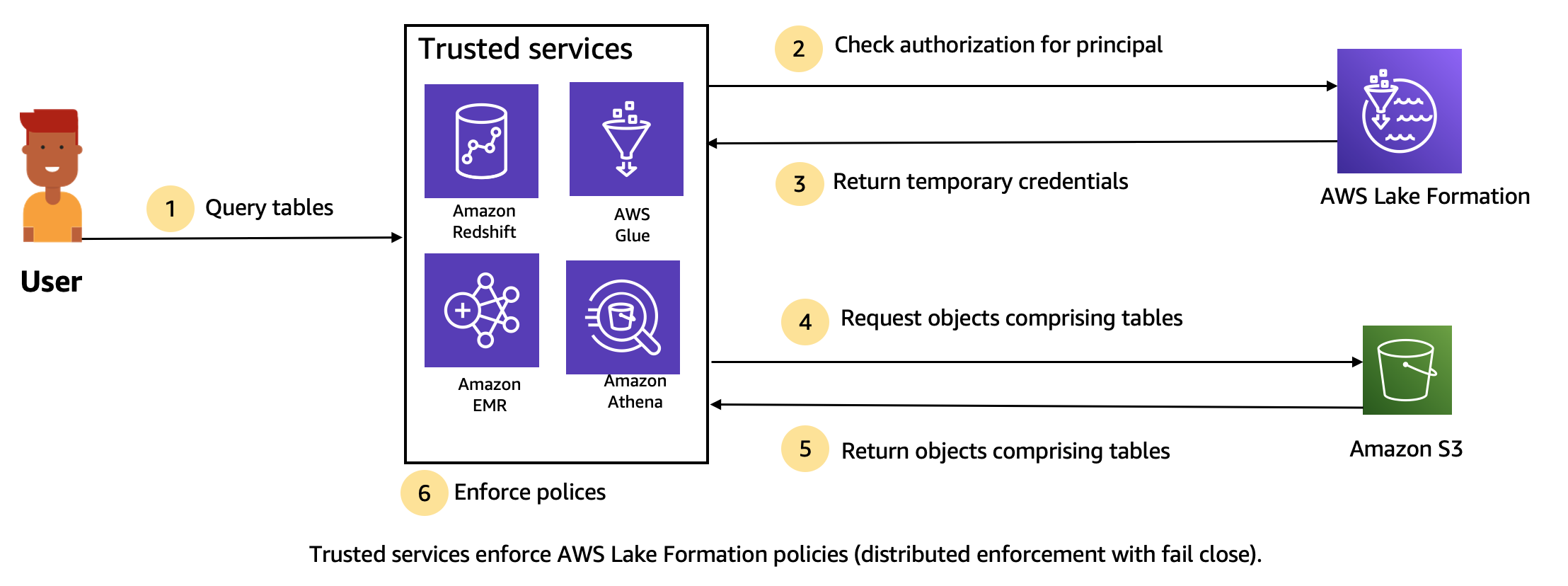Storage access management
Lake Formation uses credential vending functionality to provide temporary access to Amazon S3 data. Credential vending, or token vending is a common pattern that provides temporary credentials to users, services, or some other entity for the purposes of granting short term access to a resource.
Lake Formation leverages this pattern to provide short term access to Amazon analytics services such as Athena to access data on behalf of the calling principal. When granting permissions, users don’t need to update their Amazon S3 bucket policies or IAM policies, and they don’t need direct access to Amazon S3.
The following diagram shows how Lake Formation provides temporary access to registered locations:

-
A principal (user) enters a query or request for data for a table through a trusted integrated service like Athena, Amazon EMR, Redshift Spectrum, or Amazon Glue.
-
The integrated service checks for authorization from Lake Formation for the table and requested columns and makes an authorization determination. If the user is not authorized, Lake Formation denies access to data and the query fails.
After authorization succeeds and storage authorization is turned on for the table and user, the integrated service retrieves temporary credentials from Lake Formation to access the data.
-
The integrated service uses the temporary credentials from Lake Formation to request objects from Amazon S3.
Amazon S3 provides the Amazon S3 objects to the integrated service. The Amazon S3 objects contains all the data from the table.
The integrated service performs the necessary enforcement of Lake Formation policies, such as column level, row level and/or cell level filtering. The integrated service processes the queries and returns the results back to the user.
Enable storage-level permissions enforcement for Data Catalog tables
By default, storage-level enforcement is not enabled for tables within the Data Catalog. To enable storage-level enforcement, you must register the Amazon S3 location of your source data with Lake Formation and provide an IAM role. Storage-level permissions will be enabled for all tables with the same table location path or prefix of the Amazon S3 location.
When an integrated service requests access to the data location on behalf of a user, the Lake Formation service assumes this role and returns the credentials to requested service with scoped-down permissions to the resource so that data access can be made. The registered IAM role must have all required access to the Amazon S3 location including Amazon KMS keys.
For more information, see Registering an Amazon S3 location.
Supported Amazon services
Amazon analytic services such as Athena, Redshift Spectrum, Amazon EMR, Amazon Glue, Amazon Quick Suite, and Amazon SageMaker AI integrate with Amazon Lake Formation using the Lake Formation credential vending API operations. To see a full list of Amazon services that integrate with Lake Formation, and the level of granularity and table formats that they support, see Working with other Amazon services.